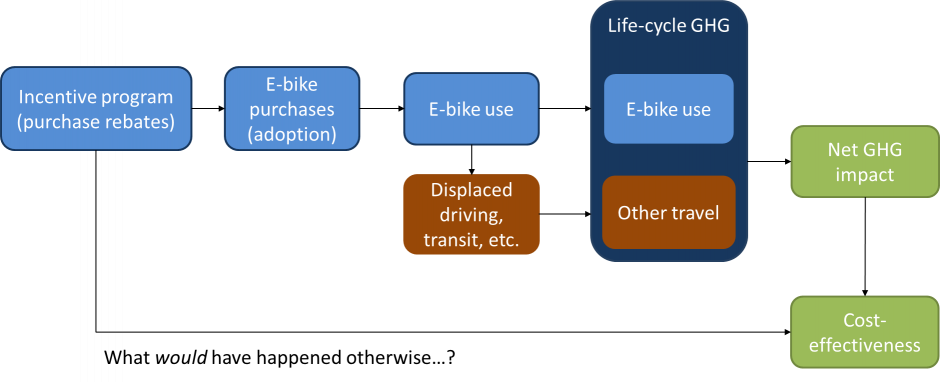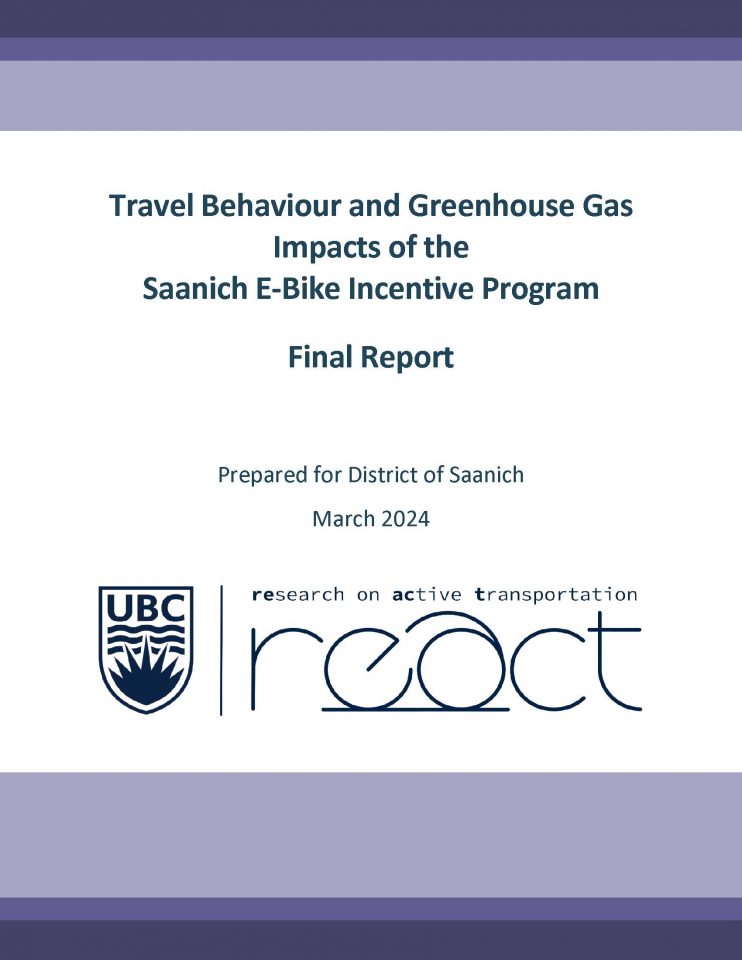Travel Behaviour and Greenhouse Gas Impacts of the Saanich E-Bike Incentive Program
Project Summary
Background & objectives
Substituting use of electric bicycles (e-bikes) for driving could reduce greenhouse gas (GHG) emissions from transportation – an essential component to meeting Canada’s climate goals. The potential emissions benefits have led to suggestions for e-bike promotion (often purchase incentives or rebates) as a climate action strategy – with co-benefits related to physical activity, traffic congestion, and more. However, to date there has been no robust quantification of the effects of e-bike purchase incentives on GHG emissions, which limits the potential for strategic use of e-bikes to contribute to achieving GHG mitigation goals. To know the role that e-bike incentives can have in climate action plans, we need to know how cost-effective those incentives are relative to other GHG mitigation strategies. Accurate quantification of program impacts requires investigation of the long-term changes in travel activity that result from e-bike adoption, and consideration of the full life-cycle emissions associated with observed and counterfactual travel activity.
The objectives of this study were to determine 1) the GHG mitigation impacts of e-bike adoption, across different segments of the population, and 2) the cost-effectiveness of e-bike purchase incentives as a GHG mitigation strategy. We aimed to create essential information for using e-bike promotion as a climate action strategy – including how effectiveness in GHG mitigation intersects with equity considerations for transportation.
Methods
This study investigated the travel behaviour and greenhouse gas (GHG) impacts of the Saanich, BC e-bike incentive program, which distributed 389 purchase rebates of $350, $800, or $1600 (income-conditioned) to eligible residents in late 2021 and 2022. A panel of 402 study participants (164 from the incentive program a control group of 238 non-incentivized purchasers of conventional or electric bicycles from the region) was recruited and surveyed in three waves (near purchase, and then 3 and 12 months later) to study short- and long-term impacts of incentivized bicycle purchases.

Findings

We found that the program attracted a large portion of new or marginal e-bike purchasers (23% to 76%, increasing with rebate level). These purchasers were highly satisfied with their new e-bikes, and used them regularly (3 to 4 days and 30 to 70 km per week). The incentive recipients reduced their auto use by 49 km per week a year after purchase, due to direct substitution of e-bike trips and broader shifts in their weekly travel habits. Larger incentives were associated with greater auto travel reduction due to higher pre-purchase auto use. Income-conditioned incentives likely enabled low-income households to actualize latent preferences for less auto dependence.
The long-run reduction in GHG from travel for the Saanich e-bike incentive recipients averaged 16 kg CO2e per week, increasing with rebate amount. The calculated marginal and non-marginal GHG abatement costs are $722 and $190 per tonne CO2e, respectively, which is cost-competitive with other types of transportation subsidies, but unlikely to be cost effective on the international carbon market. GHG reduction is one but not the only benefit of increased e-bike adoption, which can also increase physical activity, reduce local air pollutant emissions, and reduce travel costs, among other benefits. Growing interest in e-bike incentive programs creates new opportunities to investigate these co-benefits, along with program effects in various scales and settings.

Final report
Download a PDF of the final report here: Final Report

Download a PDF of the Executive Summary here: Executive Summary
Journal article
Bigazzi, A., A. Hassanpour, and E. Bardutz, “Travel behaviour and greenhouse gas impacts of income-conditioned e-bike purchase incentives.” Transportation Research Part D: Transport and Environment, Vol. 138, 2025.
Project Information
Funding
This research was funded by the National Science and Engineering Research Council of Canada (NSERC Alliance Grant #ALLRP 570926 – 21), District of Saanich, Community Social Planning Council (CSPC) of Greater Victoria, Capital Regional District (CRD), One Earth Initiative Society, and Vancouver Foundation. The views expressed in this report are those of the authors and do not represent the views of the project funders.
Research Team
- Dr. Alexander Bigazzi, Principal Investigator (alex.bigazzi@ubc.ca)
Department of Civil Engineering and School of Community and Regional Planning, University of British Columbia - Amir Hassanpour, Graduate Research Assistant
Department of Civil Engineering, University of British Columbia - Emily Bardutz, Graduate Research Assistant
School of Community and Regional Planning, University of British Columbia
Acknowledgments
The authors would like to thank the following people for offering valuable direction and advice on this project: Gurdiljot Gill, Elmira Berjisian, Fajar Ausri, Glenys Verhulst, Rebecca Newlove, Diana Gibson, Chelsea Power, Dagmar Timmer, and Matt Greeno. We would also like to acknowledge the time and valuable input from all the survey participants.